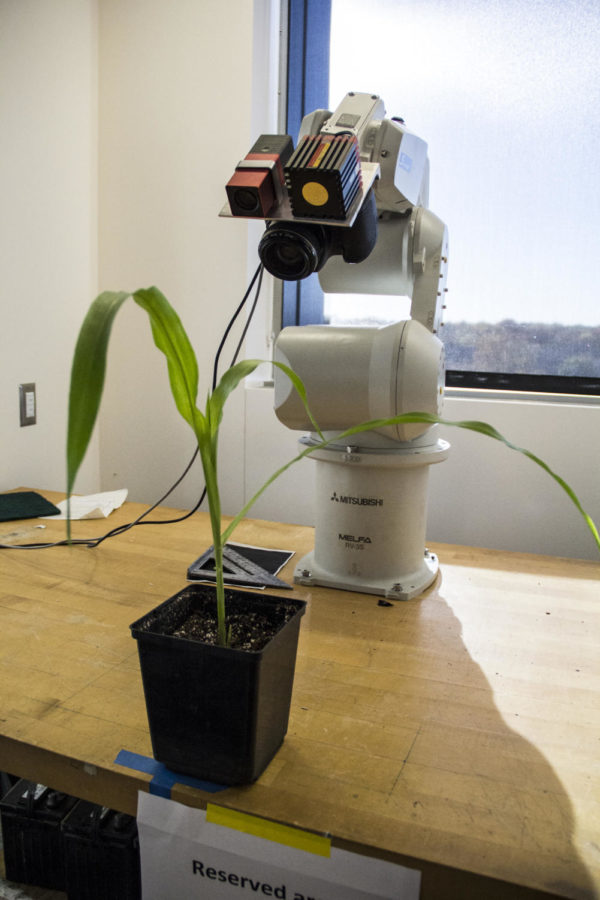The future of plant research: Robotics paves the way for plants
Kelby Wingert/Iowa State Daily
Within three years, a team of ISU faculty members hope to control several different growing environments and collect plant growth data with a robotic arm on a rover.
October 21, 2014
Enviratron may sound like a villain from the latest “Transformers” movie, but ISU researchers are actually using the robot technology to measure plant growth.
Within three years, a team of ISU faculty members hope to control several different growing environments and collect plant growth data with a robotic arm on a rover.
Stephen Howell, professor of genetics, development and cell biology and operations coordinator for Enviratron, said five years ago a colleague suggested Iowa State needed a new facility to observe plant growth.
The current commercial system is a moving conveyor belt that transfers plants to stationary sensors monitoring their growth.
“I suggested instead of using conveyer belts we could use robots — let the robot carry the sensors,” said Lie Tang, associate professor in agriculture and biosystems engineering and co-principle investigator of the project.
The robot would travel in between the growth chambers, taking readings of plant growth and allowing the plants to stay stationary.
The chambers will allow researchers to control the environment in each individual enclosure. The purpose of Enviratron is to help supplement climate change research.
Steven Whitham, professor of plant pathology and microbiology and primary investigator of the project, said they will be able to control light, humidity, temperature, watering, delivery of nutrients and carbon dioxide levels in the chambers.
The National Science Foundation was impressed with Enviratron and awarded faculty members a $929,773 grant to build it. They hope to have a working prototype of the robot and one chamber by next year.
Tang said the project is being funded as a major research instrument. A requirement for receiving funding as a research instrument is that the project must be useful for many programs and benefit researchers. The plan is to have eight chambers within three years.
Howell said the chambers will be about 8-by-3 feet, allowing around 20 different plants to grow at a time depending on the size of the plants.
Whitham said Enviratron will be able to create a huge data set.
“The most exciting thing is potentially you could monitor a plant continuously,” Whitham said. “It creates new challenges for how we analyze all of these reams of data and how we interpret it.”
With Enviratron’s ability to monitor plants continuously, Whitham expects to find much more depth in the data set revealing new traits or responses in growing plants.
Whitham said that with the amount of data collected researchers will have to collaborate with people who are able to handle large data sets. It will also become an interdisciplinary field, meaning researchers would have to work with people experienced in statistics and bioinformatics.
“A student would really benefit if they could learn from a collaborator,” Whitham said.
The biggest challenge for researchers will be deciding what sensors to use and how they should be programmed to collect data.
“If you mount the sensor to a fixed position and put the plant in, you’re limited by what you can do,” Tang said, “With [a] robotic arm you can have intelligence incorporated with the data sample.”
Tang is working on creating cameras that will be able to project 3D images because researchers currently have to take 2D images, according to Whitham.
The sensor will be able to take a picture and the decide where to go to take a data sample. It should be able to detect which leaf to clamp down on and take a reading.
Tang is currently zeroing in on a robotic arm for the rover. His criteria for a good candidate includes cost, payload, reach and degrees of freedom.
Tang said the human wrist, elbow, shoulder and waist together have seven degrees of freedom. Higher degrees of freedom will give the robotic arm higher dexterity.
Percival Scientific had created prototype growth chambers in the Roy J. Carver Co-Lab. Howell said they were very happy with the chambers and Percival Scientific said they may be able to create chambers for the Enviratron.
The chambers will have a vestibule with a door that will allow the robot to enter. After the door closes, the robot will adjust to the environment and then enter the chamber through a curtain.
“We’re having to integrate this whole thing with the rover and the chamber — that’s the big challenge at this point,” Howell said.
When the project is fully operational, they want to be able to allow the public to come and see how Enviratron works to hopefully to spark interest and show the public that they are serious about researching the effects of climate change.
“No matter if its business or technology, robots are going to be a leading trend in technology,” Tang said.







